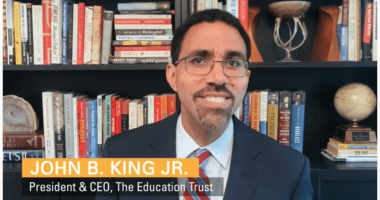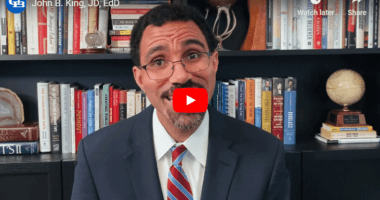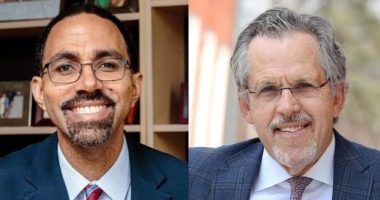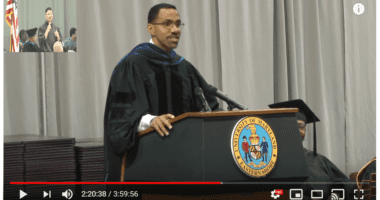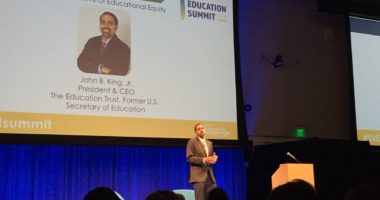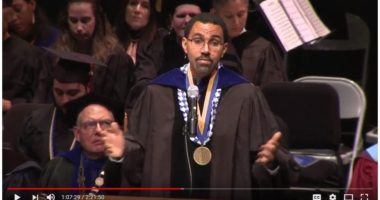John B. King Jr. Speaks with AASA’s Urban Superintendents Academy
In Alexandria, Va., John King spoke to AASA – The School Superintendents Association, noting that this fall is not the typical start of the school year. King called on education leaders to support students as they process recent events in Charlottesville and to be true champions of equity.
Good afternoon, everybody.
We come together at a wonderful time of year. The school year is about to begin. We have seen over these last few days, students arriving in schools, arriving in classrooms, excited about the new school year. Yet, we also share the knowledge that we come together at a moment that—for our country—we cannot accept as normal. This is not the typical start of the school year.
Our kids—our children—have watched on TV as Nazis and the KKK marched in the street. Kids have watched on TV as folks have chanted anti-Semitic slogans, chanted racist slogans, lifted up racist symbols. Our kids have watched as lives have been taken due to domestic terrorism. Our kids have seen firsthand the ways in which our nation struggles over issues of race and bias. They have seen the ways in which our nation struggles to name and resolve those issues. They have seen the ways in which our nation’s history remains with us today.
We must acknowledge that this year—this start of the school year—is different for those reasons. It means that all of us are charged with ensuring that when our kids come to school this year they know, first and foremost, that they are loved and valued regardless of their race, how much money their parents make, their immigration status, or their LGBTQ status. We have to send a clear message to every child on their first day in school: “We love you and we welcome you here.”
We also need to put the events our children have seen in context. For many teachers, some of their first conversations with students will be about the events in Charlottesville. Their first conversations will be about the hatred their kids have seen on TV each night—or the hatred they have witnessed in their own community. As they have that conversation, it will be critical to help students understand the historical context for what they are observing. Our students need to understand what it is about our history that gives the context for this moment.
They need to understand the context of the horrors of slavery, of the Civil War, of Reconstruction, of the birth of the KKK, of the imposition of Jim Crow. They have to understand that context. But they also have to understand that those things represent just one part of the American story—that ultimately the American story, we are blessed to say, is one of expanding opportunity.
We have to help children understand that historical context not in a sense of defeat, but in a sense of purpose—to realize that generations before them in this country have fought against oppressive systems, and have overcome those systems, and helped us to make progress.
We can’t let cynicism crowd out hope.
We also have to teach our children that they are responsible for that work, that they are inheritors of the task of bringing America more fully toward its fundamental values around equality and opportunity. That’s their job too.
The work of civic education—of understanding how a bill becomes a law, understanding why it’s important to vote and participate in the political process, understanding why we must protest and march, and why we must be loud about issues of equity and social justice—that too—must be a part of what students experience in school.
So, we have to acknowledge that this start of the school year is different and ask what we can do to make sure that our students hear loud and clear a message of love, a message of hope, and a message of responsibility.
And we have to acknowledge that what happened in Charlottesville is one manifestation of racism, but it is not the only manifestation of racism.
We have to acknowledge the educational inequities that we see—they, too, are a manifestation of institutional racism. They, too, are a manifestation of a history of bias and inequality—and we can do something about that. That’s why I’m particularly glad to be here with all of you, because, together, we can do something about that.
So that’s what I want to focus our conversation on today: What it means for us, as educators, to be champions of equity.
First, we have to focus on what it means to acknowledge the scope of the problem. You can’t solve a problem that you don’t know exists. We have to comb out the scope of the problem. We have to acknowledge the extent of the achievement gaps that face our low-income students and students of color. We have to acknowledge the results of the National Assessment of Educational Progress and our state tests. We have to acknowledge 30- to 40-point achievement gaps between low-income students, students of color, and their more advantaged peers. And we have to acknowledge that all this is not okay.
Even though we have the highest graduation rate from high school that we’ve ever had as a country, we still see 10-, 15-, 20-point gaps for African American students, for Latino students, for low-income students, for English-learners, and student with disabilities. We have to confront the reality that, although we know a postsecondary education is absolutely crucial to success in a 21st century economy, affluent kids are 6 times as likely as low-income students to graduate from college. We have to acknowledge those gaps.
We have to acknowledge the reality, Sharon mentioned, of exclusionary discipline. We have to acknowledge that exclusionary discipline is a part of the school-to-prison pipeline. It is a part of the reason that young African-American men are projected to be more likely to engage in the criminal justice system than to graduate with a bachelor’s degree. We have to acknowledge that, then act on those realities.
We have to acknowledge those gaps and acknowledge the ways that schools are a reflection of our nation’s historic challenges around issues of race, and then we have to act on them. We also have to act on the reality that if we don’t do it, our kids’ lives are at stake.
Sharon mentioned my journey. I stand here today—and clear as day—I will tell you the only reason I’m standing here is because of the difference that teachers in the New York City public schools made in my life.
My mom passed away when I was eight, in October of my fourth grade year. I was living with my father who was struggling with undiagnosed Alzheimer’s disease. I didn’t know from one night to the next what my father was going to be like. Some nights he was angry; some nights he was sad. Some nights he would talk to me; some nights he wouldn’t.
I recall a night when he woke me up at two in the morning and said it was “time to go to school.” And I remember being on the staircase of the house, clinging to the banister, my father pulling me down the stairs saying it was “time to go to school.” And I said, “No daddy, it’s not time to go to school—it’s the middle of the night.” And I didn’t know what was wrong with him. I didn’t know why he was like that. His condition got worse and worse. He passed away when I was twelve.
My life could’ve gone in a lot of different directions. I could easily be in prison or dead today, but for the New York City public school teachers in my life. But for Mr. Osterweil, who was my teacher at P.S. 276 in Canarsie in fourth, fifth, and sixth grades. Not a lot of public officials put in their official bio their elementary school, but I always did because the teachers of P.S. 276 saved my life.
Mr. Osterweil made school this place that was safe and engaging and interesting and supportive. He made school a place where I could be a kid when I couldn’t be a kid at home. I was also fortunate at Mark Twain Junior High School on Coney Island to again have teachers who gave me a sense of hope and possibility when every message in my life that I heard outside of school was counter to that. They saved my life.
That’s what’s at stake for our kids. The future of our society is at stake, for exactly the reasons Sharon said: The majority of our kids are eligible for free and reduced priced lunch, the majority of our kids are kids of color. And if we fail to educate low-income students and kids of color, we have no future as a country. And, so too, if we fail the children who are in front of us every day, their lives are at stake. So often we don’t know what’s going on in a child’s life outside of school. My teachers didn’t know what was going on at home, they just made school this place that made all the difference. We don’t always know which kids in our classes are dealing with domestic violence at home, or are homeless, or are hungry. And if we do, we have to intervene, but sometimes we don’t know these things. But we do have the moral responsibility to make sure school is a place where children can be nurtured and supported. So, what does that mean? How can we execute on this response?
I want to focus on three important things that all of us can work on together.
One of the things is this—at the heart of school is the relationship between kids and teachers, and the work in which they are both engaged.
Fundamentally, our responsibility as leaders of institutions—yes, we have to deal with buses; and, yes, we have to make sure the food is served; and, yes, we have to deal with the HR office; and, yes, we have to balance the budget; and, yes, we have to talk to our board members—but ultimately, the core of the job is the relationship between teachers and students, and the work in which they are engaged.
That means we have to do everything we can to give our teachers the best support, professional development, training, continuous feedback, and everything we can to make sure they are prepared to make class great for kids.
And we’ve got to be conscious that, too often, the work in which our kids are engaged is not sufficient to prepare them for college and career.
We have a project at The Education Trust where we looked at assignments. We worked with seven school districts and collected thousands of assignments and asked, “Do these assignments reflect college- and career-readiness expectations? And we compared the standards people said they were working toward to the work students are engaged in. For example, we found that everybody said they were working on writing and that writing was hugely important. They knew that writing was critical to kids’ success in high school and beyond. But of all the assignments we looked at in middle school, only 6 percent required writing more than one or two sentences.
So there’s this gap between what we say we want and what is actually happening.
If you want to take a look at the questions of—“What are the assignments? What is the work?”—you can go on our website—edtrust.org—and find the reports we’ve done on English language arts and mathematics. And you can find tools to look at assignments and ask: “Is the work in which students are engaged the work that will prepare them for college and career success?”
We also know that, too often, low-income students and students of color don’t have access to the very courses that are essential to get into college, much less succeed in college. In the civil rights data collection that Sharon mentioned we did at the U.S. Education Department, we found that low-income students and students of color disproportionately attend schools where you do not even take physics, chemistry, or Algebra II. You can’t even take these courses.
We say, as a country, that we want more young people prepared for STEM careers, we want more diversity in STEM fields and, yet, in some schools you can’t even take those courses.
We know that low-income students are less likely to have the most effective teachers, less likely to have access to AP classes and International Baccalaureate classes, less likely to have dual-enrollment opportunities, less likely to have college counselors to help them navigate the process to gain admission to college.
We can do something about that.
Our work has to be about the academic core mission: the support we provide to our teachers, the quality of work our students are engaged in, the courses offered in our high schools, and the work we do to help students aspire to postsecondary success.
And sometimes it’s small things.
I think about the state of Louisiana. The state of Louisiana has a project where they are planning to make completing the FAFSA part of their graduation requirements. Now, students can opt-out. They only have to sign a form that says, “You do know there are billions of dollars available through filling out the FAFSA. If you don’t want to fill it out you can sign this opt-out form, but realize you may be leaving money on the table that your child could use for college.”
The requirement hasn’t even gone into place and the state already has seen a dramatic increase in FAFSA completion. That means young people now understand there is money available for them: Pell Grants, scholarships, aid from institutions, aid from states. There is money for students to go to college and that notion is shifting students’ aspirations about college.
That’s something we can do in every one of our high schools.
We can identify who is completing the FAFSA, find out whether they have done it on time, and we can make sure that they begin to have that sense that college is accessible to them.
The second body of work is something that I know Sharon is deeply committed to—it’s the equity work that the superintendents’ association also does. And it entails rejecting the false dichotomy that says that all the answers to solving our educational challenges are in school or all the answers are outside of school. All right? That’s right.
The folks who want to debate, “Well these kids are poor, they come from a single-parent household…what do you expect them to achieve?” Right? Right. We’ve all heard that.
I think about when I was doing a tour when I was state commissioner of education in New York. I was doing a tour of a high school and I asked the principal, “What’s the graduation rate here?” and she said, “Well … you know … a lot of kids are from the public housing project across the street.” And I said, “That’s right … but what’s the graduation rate?” For her, that was the answer: “Do you know where they’re from?”
We have a responsibility to say that can’t be right. We can’t assume—because our kids are low income, because they speak Spanish at home, because one of their parents is incarcerated—that they can’t succeed. At the same time, we have to reject the argument that school is all that matters, because a hungry child is going to struggle to learn. The best teacher can’t be effective for a kid who isn’t in class. We have to acknowledge that we need to do work in schools and we need to do work in communities.
What does that look like?
Well, Sharon has a project around making sure that the enrollment process is used each year to help families get access to healthcare. Having health insurance makes a difference not only for the health and wellbeing of the child, but also for the health and wellbeing of the parent. Making sure that our families are getting their young children enrolled in Pre-K matters. We know the return on investment for Pre-K—for every dollar invested in Pre-K—we get a return on that investment of 8 to 1, 9 to 1. Pre-K not only has long-term academic benefits, but also long-term benefits for social-emotional well-being.
Jim Heckman, the Nobel Prize winning economist, has done studies showing that health outcomes are better in your twenties if you were in quality Pre-K. That’s what is at stake. We’ve got to work on that.
There was just a study done in Baltimore on glasses. If you can’t see the board, if you can’t read the book, it turns out that’s a problem for your academics. [Laughter.] The bottom line of that study was that if you help kids to get glasses, their academic outcomes are better. All of us in our communities can deliver the message that we are going to do everything we can to make sure every teacher and every principal is as effective as possible. And as a community, we have to address issues like access to early learning, access to healthcare, access to food.
Many kids in the summer are hungry for a variety of reasons. But one of them is that many of our most vulnerable kids who rely on free and reduced price lunch and school breakfast for their meals, don’t have access to those things in the summer.
In many places across the country it is difficult to find the school or location where you can get those meals in the summer. The result is that kids can go hungry. We can do something about that.
But, unfortunately, as a society we haven’t been willing to pay for that in every place so there are kids here in this state of Virginia that were hungry this summer. We can do something about that. As educators we have a responsibility not only to teach in our communities, but to lead and take that on.
We have a responsibility to say to kids who are chronically absent, “Why is that?” What’s going on in their lives and how can we intervene to make it different? We also can do something about exclusionary discipline and the impact that has on the school-to-prison pipeline. We can provide training for our teachers on implicit bias. We know, for example, from a study published last year by Yale University that Pre-K teachers, White and Black, when watching the same behavior from different students, were more likely to identify African-American males as the students needing intervention than white females engaging in the same behavior. What that says to me is not racism—it’s not folks walking in and saying “I want to discriminate.” It says that we live in a society where implicit bias is apparent in our culture and we have to do more to overcome that implicit bias. And that is part of how we overcome exclusionary discipline.
So with this, we think about empathy. We ask ourselves, “How do we build programs that create empathy so teachers understand not that we should look the other way when there are discipline issues, but that we should treat discipline issues in schools like we do in our families?” We know kids make mistakes. We know they need consequences, but the consequences alone are not enough to change their behavior. They also need support. They need to be taught.
We would never say to a kid who did badly on his math quiz, “Oh, no more math for you.” [Laughter] We do have that mindset with discipline, though. We say, “You’re struggling to manage your behavior—no more classroom, no more school, no more socialization for you. We’re going to exclude you.” We can do better.
So one, we’ve got to tackle the academics. Two, we’ve got to tackle the things around the academics: social-emotional learning, health and wellbeing, and we need to do that in partnership with communities.
The third thing I want to call us to do is be champions for equity. Advocates for equity. There’s a lot we can do in schools and districts. There’s a lot we can do as community leaders, but we have to be a loud voice for a more just society.
We have to say to people, “You know, actually condemning the KKK and Nazis is a really low bar.” Right? Clearly, there are some folks who are struggling with meeting that low bar, but that is a painfully low bar. It’s not enough to say you’re an ally of justice. To say you’re “against swastikas” is not enough. To say you’re an ally of justice—what it means to be an ally of justice—is to be committed to a notion of equality of opportunity. That you’re committed to investing in our children, investing in our young people.
Governor Brown of California has this important point he makes that: “Equal treatment for children in unequal situations is not justice.” So it’s not just that we need to put the same resources in higher need communities, we need to put more resources in higher needs communities. That’s the measure of whether you’re for a more just society—not just whether you can condemn domestic terrorism. The measure of whether you’re for a just society is whether you want to be sure people have access to healthcare, and whether you condemn racist marchers in Charlottesville. I want to know whether you are for people having healthcare, or whether you believe people should die for want of health. Right? And I want to know whether you believe that undocumented students have the right to be educated and feel safe and secure in their schools and communities.
So we have to be champions for equity in a broader sense than just rejecting the most virulent expressions of hate.
We have to be for an equity agenda that is about a just society that says we’re going to nurture our young people. We all have a stake in the success of every child no matter their neighborhood, no matter their income, no matter their background. The dilemma for us, I think, is that we’re at this moment, for our society, which can often feel painful. It was physically sickening to watch what happened in Charlottesville. It’s physically sickening to see the consequences of mass incarceration in our society. And it is physically sickening to think that we are a society that would allow families and young people to starve. But the question is so: what are we—what are each of us—going to do about it?
I’ll close with this point, I was listening to this interview with one of the young people—one of the campus leaders at UVA who was out there on the night folks were marching with their torches and their chants. And he said, “You know, I was standing there and thinking, ‘Are we doing this right? Are we doing what Martin Luther King would’ve done? Are we doing what the leaders of the civil rights movement would’ve done?’”
And his comment about that stayed with me because I think that is the question we all have to ask of ourselves.
Many of us in this room weren’t of an age to be on the buses for the Freedom Ride, but I’m sure all of us have asked if we were at that moral moment, where would we have been, how would we have stood up?
We don’t have to speculate on that question—here we are. Will we stand up? Will we stand up for all our kids? Will we stand up for a just society? Will we stand up for the idea that this is a society that believes in equality of opportunity? Will we stand up for civil rights? Will we stand up for the kids who are most vulnerable? Will we stand up not only to the most virulent and obvious expressions of hate, but will we also stand up to institutional racism? Will we stand up against the school-to-prison pipeline? Will we stand up to injustice that threatens the wellbeing and future of our children?
So, with that, thank you.

